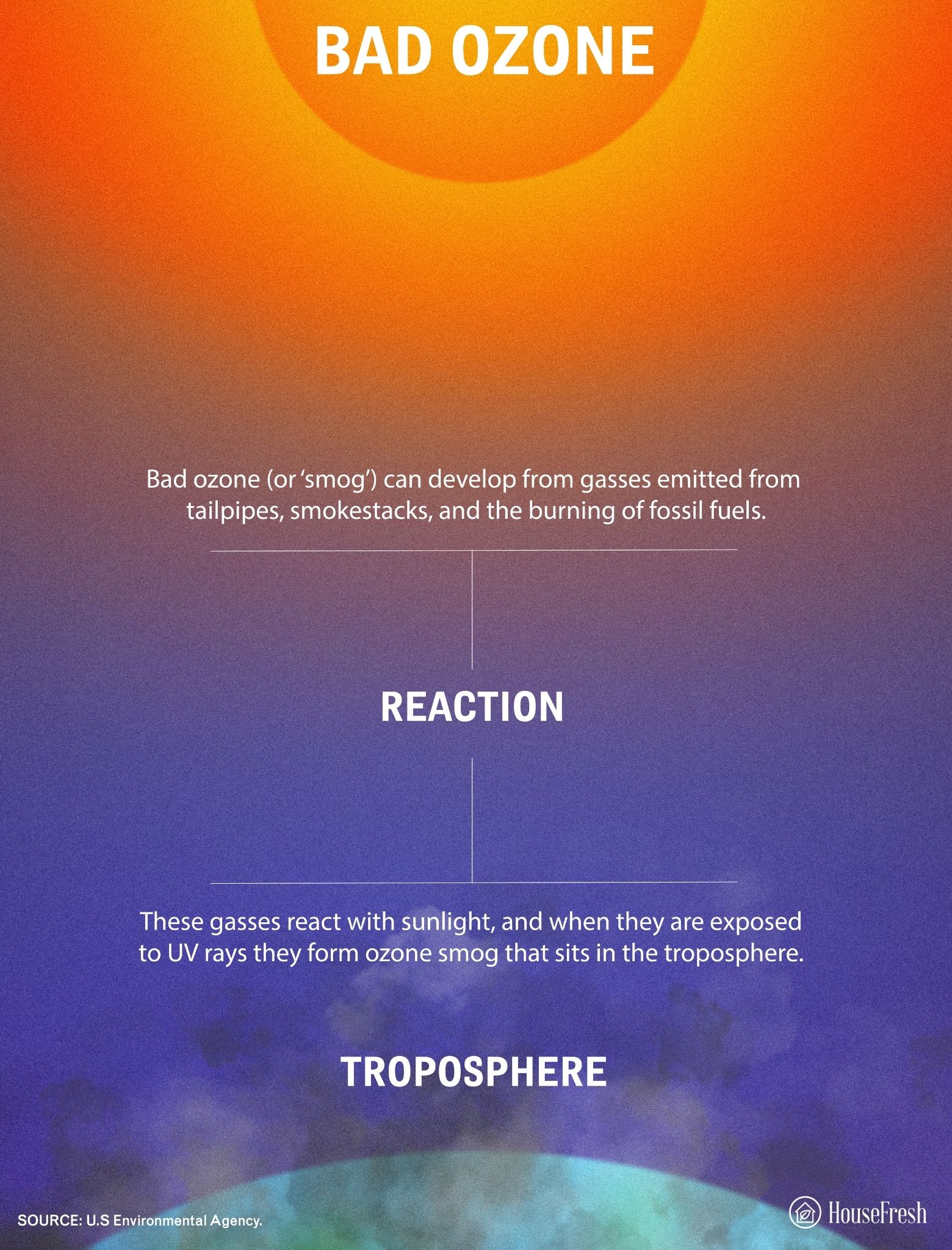You may have heard of the dangers of ozone in passing. Ozone carries vaguely sinister connotations of threats to our breathing and our planet. You may have even heard it contributes to the haze we can sometimes see out in the distance.
But what is ozone, what does it smell like, and how do you even recognize it?
According to the EPA, ozone is a type of gas that naturally occurs in the upper atmosphere. It comprises three oxygen atoms and is formed when UV radiation with the sun interacts with oxygen molecules. In its natural state in the upper atmosphere, it’s a force for good because it blocks out the amount of harmful radiation that can reach us.

However, ozone can also be manmade and ground-level, or tropospheric. High amounts of heat and sunlight can cause reactions between volatile organic compounds (VOC) and nitrogen oxides (NOx), two common air pollutants. Common sources of these pollutants include cars, trucks, gasoline vapors, chemical plants and oil-based paints. Because heat and sunlight usually cause the reactions, the smog or haze associated with ozone tends to happen in the summer. However, high mountain regions with snow or southern climates can still get ozone haze in other months, including winter.

So, what does ozone smell like?
Ozone has a distinctive smell. The California Air Resources Board reports that people say it smells like chlorine bleach. There are those who have described the smell of ozone as an electrical smell or even as a strange, sweet smell of burning plastic.
Whether you can smell it can depend on your own sensitivity levels. Some people can smell ozone when the levels are as low as 0.05 ppm (parts per million). And there are those who can even smell it during electrical charges or after lightning strikes.
8 serious health effects of ozone pollution
Ozone can cause a wide range of average effects on the body. The risks, as listed by the American Lung Association and the EPA, include:
1. Breathing problems
Greater obstruction in the airways can happen when breathing ozone, according to the EPA. Some noticeable immediate breathing problems include shortness of breath, wheezing, pain in the chest when taking a deep breath, coughing, throat irritation, chest tightness, asthma attacks, increased respiratory infection risk, pulmonary inflammation and increased hospital trips for those who have lung diseases like COPD.
2. Metabolic disorders
Research carried out by the School of Public Health in Taiwan has suggested that there is an increased risk of metabolic disorders such as diabetes if you breathe ozone for periods longer than eight hours for days, months or years, defined as long-term exposure.
3. Nervous system issues
Studies by Mexico’s National Institute of Neurology and Neurosurgery have shown that long-term ozone exposure can lead to headaches, decreased cognitive response, disturbances in the sleep-wake cycle, decrease in motor activity, neuronal dysfunctions, cell degeneration, and neurochemical alterations.
4. Reproductive issues
Research by the Federation of American Societies for Experimental Biology suggests breathing high levels of ozone could affect women’s ability to conceive. Other male and female fertility problems and poor birth outcomes are also linked with long-term ozone exposure.
5. Cancer
Different types of cancer can come from long-term ozone exposure, as well:
- A study by the University of Washington Center for Clean Air Research suggests ozone exposure increases the risk for lung cancer. However, the carcinogenic effects of ozone are not fully understood, but it is known that ozone can damage DNA and proteins in lung cells, leading to cancer. Ozone can also increase the risk of lung infection, which in turn, can lead to cancer.
- Research shows a correlation between ozone depletion and increased skin cancer incidence. This is likely because more harmful UV radiation can reach the Earth’s surface when the ozone layer is depleted, increasing a person’s risk of developing skin cancer. UV radiation is a known carcinogen, meaning it can cause cancer.
6. Cardiovascular mortality
A Peking University study showed that subjects without hypertension had a higher risk for CVD mortality associated with long-term exposure to ozone. This increased risk of cardiovascular mortality can lead to premature death.
7. Greater response to allergies
Breathing ozone can make your lungs more responsive and sensitive. According to the American Lung Association, eople with allergies may notice a stronger response to allergens from breathing ozone.
8. Premature death
When combined with other risk factors, long-term exposure to ozone can lead to premature death. A 2017 study by the Stockholm Environment Institute, showed that older adults had a higher risk of premature death, even when the ozone level was below the U.S. national standard.
Final thoughts
No one wants to die early because the air is smoggy. There are things we can all do to help.
The United States Environmental Protection Agency recommends making some lifestyle changes to reduce the air pollutants that cause ozone:
- Consider buying ENERGY STAR appliances
- If it’s possible, try carpooling or using public transportation over driving
- Be careful not to spill fuel and keep gas caps tight
- Keep your vehicle’s engine properly tuned
- Choosing environmentally safe cleaning products or paints (zero-VOC)
- Start mulching/composting yard waste
- Use gas logs to replace wood
If you’re considering buying an air purifier, make sure to buy a unit without an ionizer function to ensure it will be ozone-free. We have shortlisted the best ozone-free air purifiers in a previous article.
SOURCES
- American Lung Association. (2023). Ozone. lung.org
- California Air Resources Board. (2020). What is Ozone? arb.ca.gov
- Environmental Protection Agency. (2023). Actions You Can Take to Reduce Air Pollution. epa.gov
- Environmental Protection Agency. (2023). Health Effects of Ozone in the General Population. epa.gov
- Environmental Protection Agency. (2023). What is Ozone? epa.gov







